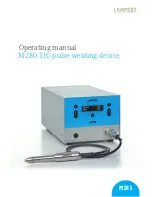
28
VIPER MULTI 165
OPERATING MANUAL
11. MIG: Welding Guide
11.1 MIG (Metal Inert Gas) Welding
MIG (Metal Inert Gas) welding, also known as GMAW (Gas Metal Arc Welding) or MAG (Metal Active Gas Welding), is a
semi-automatic arc welding process in which a consumable wire electrode and a shielding gas are fed through a welding
gun. A constant voltage and direct current power source is most commonly used with MIG welding.
There are four primary methods of metal transfer in MIG welding. Short circuit (also known as dip transfer), globular
transfer, spray transfer and pulse spray, each of which has distinct properties and corresponding advantages and
limitations. To perform MIG welding, the necessary equipment is a welding gun, a wire feed unit, a welding power supply,
an electrode wire, and a shielding gas supply.
11.2 Short Circuit Transfer
Short circuit transfer is the most commonly used method whereby the wire electrode is fed continuously down the welding
torch through to and exiting the contact tip. The wire touches the workpiece and causes a short circuit. The wire heats up
and begins to form a molten bead, the bead separates from the end of the wire and forms a droplet that is transferred into
the weld pool. This process is repeated about 100 times per second, making the arc appear constant to the human eye.
Short Circuit
Droplet separates
Wire Heating
Arc flattens droplet
Magnetic field
pinches wire
Cycle repeats
The wire approaches the workpiece and
touches the work, creating a short circuit
between the wire and the base metal, because
there is no space between the wire and the
base metal there is no arc and current flows
through the wire.
The pinch causes the forming droplet to
separate and fall towards the forming
weld pool.
The wire cannot support all the current flow,
resistance builds up and the wire becomes hot
and weak and begins to melt.
An arc is created at the separation of the
droplet and the heat and force of the arc
flattens out the droplet into the weld pool. The
heat of the arc melts the end of the wire slightly
as it feeds towards the base metal.
The current flow creates a magnetic field that
begins to pinch the melting wire forming it into
droplet.
The wire feed speed overcomes the heat of the
arc and the wire again approaches the work to
short circuit and repeat the cycle.
















































